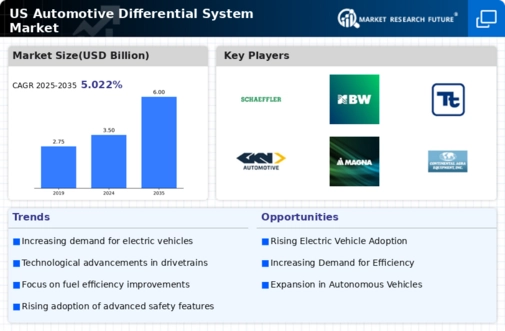The automotive differential system market is characterized by a competitive landscape that is increasingly shaped by innovation, strategic partnerships, and a focus on sustainability. Key players such as GKN Automotive (US), Dana Incorporated (US), and BorgWarner Inc. (US) are actively pursuing strategies that enhance their market positioning. GKN Automotive (US) emphasizes technological advancements in electric vehicle (EV) applications, while Dana Incorporated (US) focuses on expanding its product portfolio to include more efficient and sustainable solutions. BorgWarner Inc. (US) is also investing in hybrid and electric technologies, indicating a collective shift towards electrification that is likely to redefine competitive dynamics in the market.
The market structure appears moderately fragmented, with several players vying for market share through localized manufacturing and supply chain optimization. Companies are increasingly localizing their production facilities to reduce lead times and enhance responsiveness to regional demands. This tactic not only improves operational efficiency but also allows for better alignment with local regulations and consumer preferences. The collective influence of these key players suggests a competitive environment where innovation and operational agility are paramount.
In November 2025, GKN Automotive (US) announced a partnership with a leading EV manufacturer to develop advanced differential systems tailored for electric vehicles. This collaboration is strategically significant as it positions GKN at the forefront of the EV market, allowing them to leverage their expertise in lightweight materials and advanced manufacturing techniques. Such partnerships are likely to enhance their competitive edge and drive future growth.
In October 2025, Dana Incorporated (US) unveiled a new line of high-performance differentials designed specifically for off-road vehicles. This launch reflects Dana's commitment to diversifying its product offerings and catering to niche markets. By focusing on specialized applications, Dana aims to capture a larger share of the off-road segment, which is experiencing increased demand due to the growing popularity of recreational vehicles.
In September 2025, BorgWarner Inc. (US) completed the acquisition of a technology firm specializing in AI-driven automotive solutions. This acquisition is pivotal as it enables BorgWarner to integrate advanced AI capabilities into their differential systems, enhancing performance and efficiency. The move underscores the importance of technological integration in maintaining a competitive advantage in an increasingly digital marketplace.
As of December 2025, current trends in the automotive differential system market are heavily influenced by digitalization, sustainability, and the integration of AI technologies. Strategic alliances are becoming more prevalent, as companies recognize the need to collaborate in order to innovate and meet evolving consumer demands. The competitive landscape is shifting from traditional price-based competition to a focus on technological innovation and supply chain reliability. This evolution suggests that companies that prioritize R&D and strategic partnerships will likely emerge as leaders in the market.



















Leave a Comment